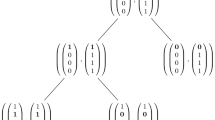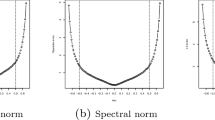Abstract
We show a branch and bound approach to exactly find the best sparse dimension reduction of a matrix. We can choose between enforcing orthogonality of the coefficients and uncorrelation of the components, and can explicitly set the degree of sparsity. We suggest methods to choose the number of non-zero loadings for each component; illustrate and compare our approach with existing methods through a benchmark data set.
Similar content being viewed by others
References
Cadima J, Jolliffe IT (1995) Loadings and correlations in the interpretation of principal components. J Appl Stat 22: 203–214
Cattell RB (1966) The meaning and strategic use of factor analysis. In: Handbook of multivariate experimental psychology. Springer, Heidelberg
Chatfield C, Collins AJ (1980) Introduction to multivariate analysis. Chapman and Hall, London
Coleman TF, Li Y (1994) On the convergence of reflective Newton methods for large-scale nonlinear minimization subject to bounds. Math Program 67: 189–224
Collins J, Jaufer D, Vlachos P, Butler B, Suguru I (2004) Detecting collaborations in text comparing the authors’ rhetorical language choices in The Federalist Papers. Comput Hum 38: 15–36
d’Aspremont A, El Ghaoui L, Jordan M, Lanckriet GRG (2007) A direct formulation for sparse PCA using semidefinite programming. SIAM Rev 49: 434–448
Gill PE, Murray W, Wright MH (1981) Practical optimization. Academic Press, London
Guyon I, Elisseeff A (2003) An introduction to variable and feature selection. J Mach Learn Res 3: 1157–1182
Hand DJ (1981) Branch and bound in statistical data analysis. Statistician 30
Harrison D, Rubinfeld DL (1978) Hedonic prices and the demand for clean air. J Environ Econom Manage 5: 81–102
Horn JL (1965) A rationale and test for the number of factors in factor analysis. Psychometrika 30: 179–185
Jeffers J (1967) Two case studies in the application of principal components. Appl Stat 16: 225–236
Jolliffe I (2002) Principal component analysis. Springer, Heidelberg
Jolliffe IT (1995) Rotation of principal components: choice of normalization constraints. J Appl Stat 22: 29–35
Jolliffe IT, Trendafilov NT, Uddin M (2003) A modified principal component technique based on the lasso. J Comput Graph Stat 12: 531–547
Kaiser HF (1960) The application of electronic computers to factor analysis. Educational Psychol Measurement 20: 141–151
Miller A (1990) Subset selection in regression. Chapman and Hall, London
Moghaddam B, Weiss Y, Avidan S (2006) Spectral bounds for sparse PCA: exact and greedy algorithms. Adv Neural Inf Process Syst 18
R Development Core Team (2007) R: A Language and Environment for Statistical Computing. R Foundation for Statistical Computing, Vienna, Austria
Trendafilov NT, Jolliffe IT (2006) Projected gradient approach to the numerical solution of the SCoTLASS. Comput Stat Data Anal 50: 242–253
Wilkinson JH (1965) The algebraic eigenvalue problem. Oxford University Press, Oxford
Zou H, Hastie T (2005) Regression shrinkage and selection via the elastic net. J Royal Statistical Soc (Ser. B) 67: 301–320
Zou H, Hastie T, Tibshirani R (2004) Sparse principal components analysis. Technical Report, Department of Statistics, Stanford University, USA
Zwick WR, Velicer WF (1986) Comparison of five rules for determining the number of components to retain. Psychol Bull 99: 432–442
Author information
Authors and Affiliations
Corresponding author
Rights and permissions
About this article
Cite this article
Farcomeni, A. An exact approach to sparse principal component analysis. Comput Stat 24, 583–604 (2009). https://doi.org/10.1007/s00180-008-0147-3
Received:
Accepted:
Published:
Issue Date:
DOI: https://doi.org/10.1007/s00180-008-0147-3




